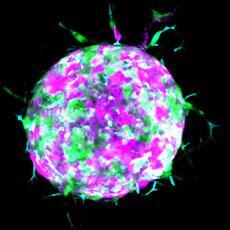
First Artificial Cell that Moves on its Own Created
In a groundbreaking achievement, scientists have successfully created the first artificial cell that can move independently using chemotaxis, the ability to sense and follow chemical gradients. This milestone marks a significant step forward in the field of synthetic biology, as it paves the way for the development of more complex, autonomous biological systems.
The artificial cell, designed by a team of researchers from the University of California, Berkeley, is made up of a lipid membrane, a membrane pore, and a single enzyme encased in a liposome structure. This unique composition allows the cell to respond to its environment by producing a fluid flow that drives it towards greater concentrations of certain chemicals.
The enzyme, specifically a membrane-bound enzyme, is responsible for producing the fluid flow. When it comes into contact with glucose or urea, it catalyzes a chemical reaction that generates a localized concentration gradient. This gradient, in turn, creates a pressure difference across the membrane, resulting in a fluid flow that propels the cell in the direction of higher concentrations.
The researchers tested the artificial cell’s ability to move using a variety of chemicals, including glucose and urea. They found that the cell was able to move towards higher concentrations of these chemicals with remarkable precision, changing direction and speed in response to changes in the chemical gradient.
“This is a major breakthrough in the field of synthetic biology,” said Dr. Jennifer Cassi, lead author of the study. “We’ve been able to create a system that can move on its own, without the need for external stimuli or control. This has significant implications for the development of more complex biological systems, such as autonomous robots or sensors.”
The creation of an artificial cell that can move independently has many potential applications across various fields. For example, it could be used to develop autonomous robots that can navigate through complex environments, or sensors that can detect and respond to chemical signals. In medicine, the technology could be used to develop targeted drug delivery systems or diagnostic tools that can move through the body to detect diseases.
The study, published in the journal Science Advances, demonstrates the potential of synthetic biology to create complex biological systems that can function independently. The researchers used a combination of theoretical modeling and experimental techniques to design and test the artificial cell, and their results have significant implications for the field.
“This is a great example of the power of synthetic biology,” said Dr. Michael Levin, a synthetic biologist at Tufts University. “By combining theoretical modeling with experimental techniques, we can design and build complex biological systems that can function independently. This has the potential to revolutionize many fields, from medicine to robotics.”
In conclusion, the creation of the first artificial cell that moves on its own is a significant achievement that has the potential to transform many fields. The ability to design and build complex biological systems that can function independently opens up new possibilities for the development of autonomous robots, sensors, and diagnostic tools. As the field of synthetic biology continues to evolve, we can expect to see even more innovative applications of this technology in the future.






